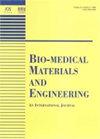预测血液透析动静脉瘘吻合角度,规范手术技术。
IF 1.3
4区 医学
Q4 ENGINEERING, BIOMEDICAL
引用次数: 0
摘要
背景动静脉瘘(AVF)是血液透析中首选的血管通路。瘘管失败的主要原因是内膜增生(IH),导致狭窄。壁面剪切应力(WSS)和扰动流是IH形成的关键参数。目的探讨吻合角度对WSS和静脉流出率的影响,寻找理想的AVF吻合角度,规范手术技术。方法本研究考虑了五种不同吻合角度的端侧型AVF的三维理想几何形状。使用数值模拟技术计算非牛顿脉动血流的WSS,即静脉出口处的血液流速。结果与其他角度相比,75°处的WSS更高,脉动动脉流入的WSS至少在45°处。WSS在30°、60°和90°时为中度。在动脉床和静脉外壁上,在吻合后立即观察到再循环区。吻合角度为45°和90°时,远端静脉流出率较高。结论:如果认为高壁剪切应力导致AVF内的IH,则结果表明AVF应以45°角形成以避免IH。然而,如果认为低壁剪切应力导致AVF内的IH,则结果表明AVF应在30°或75°处形成,以避免IH。这些发现强调了吻合角度在确定AVF血流动力学中的重要性。本文章由计算机程序翻译,如有差异,请以英文原文为准。
Prediction of the anastomosis angle of arteriovenous fistula in hemodialysis to standardize the surgical technique.
BACKGROUND
Arteriovenous fistula (AVF) is the preferred route of vascular access in hemodialysis. The primary reason of fistula failure is Intimal hyperplasia (IH), which leads to stenosis. Wall shear stress (WSS) and disturbed flow are the critical parameters in the formation of IH.
OBJECTIVE
The primary goal of this study is to explore the influence of anastomosis angle on WSS and venous outflow rate, as well as to find the ideal angle of anastomosis for AVF to standardize surgical technique.
METHODS
Three-dimensional idealized geometries of end-to-side type AVF for the five various angles of anastomosis are considered in this study. The WSS, blood flow rate at the venous outlet for non-Newtonian, pulsatile blood flow are calculated using a numerical simulation technique.
RESULTS
The WSS is higher at 75° compared to other angles and least at 45° for pulsating arterial inflows. The WSS is moderate at 30°, 60° and 90°. On the arterial bed and outer wall of the vein, immediately after the anastomosis, the recirculation zone is observed. At an angle of 45° and 90° anastomosis, the outflow rate is greater at distal venous end.
CONCLUSIONS
If one believes that high wall shear stress causes IH within the AVF, the results suggest that the AVF should be formed at a 45° angle to avoid IH. However, if one believes that low wall shear stress causes IH within the AVF, the results suggest that AVF should be formed at either 30° or 75° to avoid IH. The findings spotlight the importance of anastomosis angle in determining AVF hemodynamics.
求助全文
通过发布文献求助,成功后即可免费获取论文全文。
去求助
来源期刊

Bio-medical materials and engineering
工程技术-材料科学:生物材料
CiteScore
1.80
自引率
0.00%
发文量
73
审稿时长
6 months
期刊介绍:
The aim of Bio-Medical Materials and Engineering is to promote the welfare of humans and to help them keep healthy. This international journal is an interdisciplinary journal that publishes original research papers, review articles and brief notes on materials and engineering for biological and medical systems. Articles in this peer-reviewed journal cover a wide range of topics, including, but not limited to: Engineering as applied to improving diagnosis, therapy, and prevention of disease and injury, and better substitutes for damaged or disabled human organs; Studies of biomaterial interactions with the human body, bio-compatibility, interfacial and interaction problems; Biomechanical behavior under biological and/or medical conditions; Mechanical and biological properties of membrane biomaterials; Cellular and tissue engineering, physiological, biophysical, biochemical bioengineering aspects; Implant failure fields and degradation of implants. Biomimetics engineering and materials including system analysis as supporter for aged people and as rehabilitation; Bioengineering and materials technology as applied to the decontamination against environmental problems; Biosensors, bioreactors, bioprocess instrumentation and control system; Application to food engineering; Standardization problems on biomaterials and related products; Assessment of reliability and safety of biomedical materials and man-machine systems; and Product liability of biomaterials and related products.
 求助内容:
求助内容: 应助结果提醒方式:
应助结果提醒方式:


